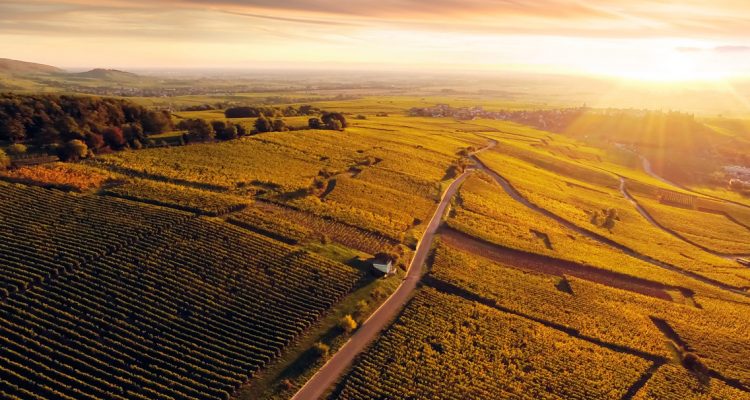(Click here to read Alsace – Part 1)
(Click here to read Alsace – Part 2)
(Click here to read Alsace – Part 3)
Here is someone who has known what they wanted to be since the age of three: Agathe Bursin, winemaker of The Agathe Bursin Winery, in Alsace, France. That was when her grandfather, who made a little wine for the family, gave Agathe a taste of grape juice. She was entranced. Even as a child, she was captivated by the process of grape juice developing into wine over the course of days, weeks, months, years.
 In grade school she was surrounded by boys, and when they drew tractors, she drew tractors. And she loved it. To this day, she vastly prefers to spend her time on a tractor, or out in the vineyards, or making wine. She doesn’t have the patience to stay inside and, say, create a website for her winery.
In grade school she was surrounded by boys, and when they drew tractors, she drew tractors. And she loved it. To this day, she vastly prefers to spend her time on a tractor, or out in the vineyards, or making wine. She doesn’t have the patience to stay inside and, say, create a website for her winery.
Back to Agathe’s grandparents, who — after keeping a small amount for family wines — took most of their grapes to the local cooperative which made the wines and sold them. When Agathe’s mother inherited some of the family vineyards about twenty years ago, she gave her share to Agathe. Which was, of course, the perfect thing to do. Since then, Agathe has concentrated on improving her grapevines and wines, using organic practices. Her wines are wonderfully appealing, emphatically stamped with her own natural energy.
STYLES OF WINE
About 90% of the wines produced in Alsace are white, mainly table wines. And there’s now about 10% of (red) Pinot Noir produced here. For food pairings, the white table wines of Alsace have plenty of body and are paired with everything from sashimi or cooked fish and seafood, to pork and chicken. The Pinot Noir wines tend to be quite delicate, and are excellent when lightly chilled and sipped before dinner, or served with a subtle light meal, such as dishes with trout or mushrooms.

Agathe Bursin also produces a beautiful late-harvest sweet wine made with the aromatic gewurztraminer grape. Traditionally in Alsace, this style of wine is called Vendange Tardive, and all the grapes must be hand-harvested. Agathe uses her own system of protecting the grapes at the heart of the vine, in order to ensure the bunches remain healthy despite threats from summer storms and increasing temperatures due to climate change. Unfortunately, the percentage of the delectable, fragrant Vendange Tardive wines produced in Alsace has markedly decreased in recent years. These wines are often paired with a blue or Munster cheese, or with a brioche-like cake called Kugelhopf. Do try one of these wines if you ever have the chance — you don’t know what you’re missing.

THE LAND
Agathe also follows the traditions of her own family. As her grandfather did, whenever it is necessary to replant vineyard areas, she uses cuttings from the finest of her old vines, rather than buying whatever the local plant nurseries have to offer. She finds that every root of every vine is different, and adds its own touch to the wine. It’s endlessly fascinating. Agathe believes: “You need more than one lifetime to understand your land.”
THE WINES
2019 Agathe Bursin Riesling “Zinnkoepfle” Grand Cru — This is not a shy wine. It’s got a big mouthfeel which smooths out the flavors, which masks some of the acidity, says Agathe. After a hint of graphite in the aroma, this wine is bursting with flavors and aromas of white fruits like peach, pear and apricot. The grapes for this wine come from one of the highest hills in Alsace, a grand cru vineyard called Zinnkoepfle which means “head in the sun.”
2018 Agathe Bursin Pinot Noir “Strangenberg” – An amazing wine chock full of aromas and flavors. I found burnt-sugar and leather undertones with strawberry, blackberry and a bit of baking spices. Agathe puts this wine in fairly neutral barriques for 18 months because she likes the micro-oxygenation of the barrels but dislikes woody flavors in her wines. She also mentioned that this wine will be best in 10-15 years when it will develop cherry and kirsch notes, with a bit of smokiness.

